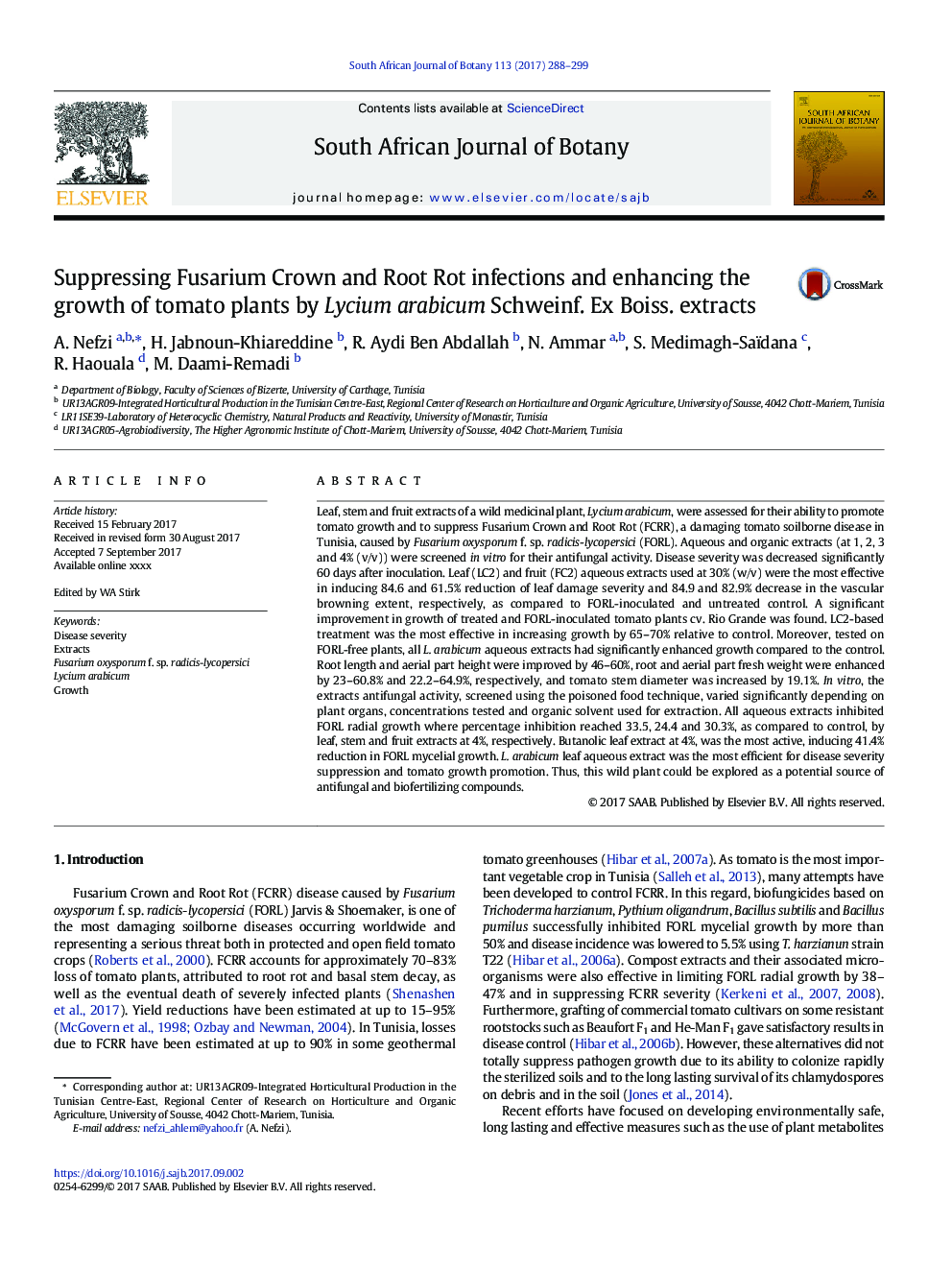| کد مقاله | کد نشریه | سال انتشار | مقاله انگلیسی | نسخه تمام متن |
|---|---|---|---|---|
| 5762917 | 1625145 | 2017 | 12 صفحه PDF | دانلود رایگان |
عنوان انگلیسی مقاله ISI
Suppressing Fusarium Crown and Root Rot infections and enhancing the growth of tomato plants by Lycium arabicum Schweinf. Ex Boiss. extracts
دانلود مقاله + سفارش ترجمه
دانلود مقاله ISI انگلیسی
رایگان برای ایرانیان
کلمات کلیدی
موضوعات مرتبط
علوم زیستی و بیوفناوری
علوم کشاورزی و بیولوژیک
علوم زراعت و اصلاح نباتات
پیش نمایش صفحه اول مقاله

چکیده انگلیسی
Leaf, stem and fruit extracts of a wild medicinal plant, Lycium arabicum, were assessed for their ability to promote tomato growth and to suppress Fusarium Crown and Root Rot (FCRR), a damaging tomato soilborne disease in Tunisia, caused by Fusarium oxysporum f. sp. radicis-lycopersici (FORL). Aqueous and organic extracts (at 1, 2, 3 and 4% (v/v)) were screened in vitro for their antifungal activity. Disease severity was decreased significantly 60Â days after inoculation. Leaf (LC2) and fruit (FC2) aqueous extracts used at 30% (w/v) were the most effective in inducing 84.6 and 61.5% reduction of leaf damage severity and 84.9 and 82.9% decrease in the vascular browning extent, respectively, as compared to FORL-inoculated and untreated control. A significant improvement in growth of treated and FORL-inoculated tomato plants cv. Rio Grande was found. LC2-based treatment was the most effective in increasing growth by 65-70% relative to control. Moreover, tested on FORL-free plants, all L. arabicum aqueous extracts had significantly enhanced growth compared to the control. Root length and aerial part height were improved by 46-60%, root and aerial part fresh weight were enhanced by 23-60.8% and 22.2-64.9%, respectively, and tomato stem diameter was increased by 19.1%. In vitro, the extracts antifungal activity, screened using the poisoned food technique, varied significantly depending on plant organs, concentrations tested and organic solvent used for extraction. All aqueous extracts inhibited FORL radial growth where percentage inhibition reached 33.5, 24.4 and 30.3%, as compared to control, by leaf, stem and fruit extracts at 4%, respectively. Butanolic leaf extract at 4%, was the most active, inducing 41.4% reduction in FORL mycelial growth. L. arabicum leaf aqueous extract was the most efficient for disease severity suppression and tomato growth promotion. Thus, this wild plant could be explored as a potential source of antifungal and biofertilizing compounds.
ناشر
Database: Elsevier - ScienceDirect (ساینس دایرکت)
Journal: South African Journal of Botany - Volume 113, November 2017, Pages 288-299
Journal: South African Journal of Botany - Volume 113, November 2017, Pages 288-299
نویسندگان
A. Nefzi, H. Jabnoun-Khiareddine, R. Aydi Ben Abdallah, N. Ammar, S. Medimagh-Saïdana, R. Haouala, M. Daami-Remadi,